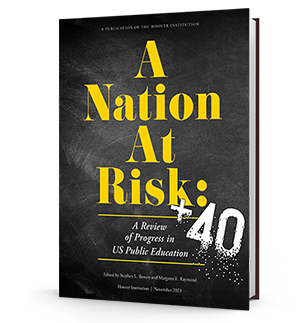
Forty years ago, the release of A Nation at Risk led to what we know today as the modern school reform movement. With its calls for increased academic rigor, more productive use of instructional time, more effective teaching, and more impactful leadership, A Nation at Risk set in motion policy and practice changes at every level of the education system. But after four decades, what has been the result? And where do we go from here?
The chapters in this series each tackle a distinct area of school reform that emerged in response to the needs described in A Nation at Risk. Each chapter provides background and context, describes the evidence of impact, draws conclusions, and makes recommendations for policymakers. The goal: to evaluate the evidence and determine what can be learned from four decades of effort to transform the nation’s schools.
Forty years on, significant challenges remain. The COVID-19 pandemic has had devastating effects on student learning, and chronic absenteeism remains at alarming rates. Even prior to the pandemic, student achievement, as measured by standardized tests, seemed to have plateaued despite ever-increasing resources—in time, dollars, research, technology, and human capital—being devoted to school reform.
Much has been tried in the effort to improve our schools. Has any of it made a difference?
Publication Chapters
As the nation’s schools face challenges in their recovery from COVID-19, there are lessons to be learned from the past forty years of reform, which are explored in the essays in this collection.
Introduction | A Nation at Risk at Forty by Stephen L. Bowen
Chapter 1 | The Imperative for High-Quality Pre-K by Deborah Stipek
Chapter 2 | A Survey of Whole-Child School Reforms by Maria D. Fitzpatrick
Chapter 3 | Strategically Prioritizing Teacher Quality and Quantity Can Reinvigorate the Teacher Pipeline by Michael Hansen
Chapter 4 | School Staffing and Teacher Quality by Thomas S. Dee
Chapter 5 | The Case for Curriculum: Since A Nation at Risk, Education Reform Efforts Have Mostly Stopped at the Classroom Door by Robert Pondiscio
Chapter 6 | The World Is a Lab: Innovation in Schools after A Nation at Risk by Eric Bettinger
Chapter 7 | Unfulfilled Promise: The Forty-Year Shift from Print to Digital and Why It Failed to Transform Learning by Tom Vander Ark
Chapter 8 | Fixing Schools through Finance by Eric Hanushek
Chapter 9 | From the One Best System to Student-Centered Systems: Lessons from a Half-Century of K-12 Governance Reform by Michael T. Hartney
Chapter 10 | School Choice Policies in the United States: Retrospect and Prospect by John D. Singleton
Chapter 11 | Standards-Based Reform by Michael J. Petrilli
Chapter 12 | Lessons from Newark: The Lineage of Modern School Reform and Where We Go Next by Cami Anderson
Conclusion | Times Have Changed. The School System? Not So Much. by Margaret E. Raymond
Policy Maker's Toolkit and Research Summaries | An Education Reform Self-Assessment
ABOUT THE HOOVER EDUCATION SUCCESS INITIATIVE
The Hoover Education Success Initiative (HESI) focuses on providing state leaders with sound research-based recommendations to improve education in America.
Since passage in 2015 of the Every Student Succeeds Act (ESSA), states have again taken charge of American education policy. That means their leaders must possess the vision, wisdom, and capacity to make the most of opportunities to better serve their students, parents, educators, and taxpayers. To support them in this ambitious undertaking, the Hoover Education Success Initiative provides policy recommendations in vital realms of K-12 schooling, grounded in expert analysis of what works.
Launched in 2019, HESI is a “solutions tank” led by senior scholars at Stanford’s Hoover Institution. Its work incorporates the best available policy evidence as compiled by panels of research leaders in specific topical areas. The policy briefings are scrutinized and honed in consultation with the HESI Practitioner Council, a group of leading state policy makers and educational reform advocates.







